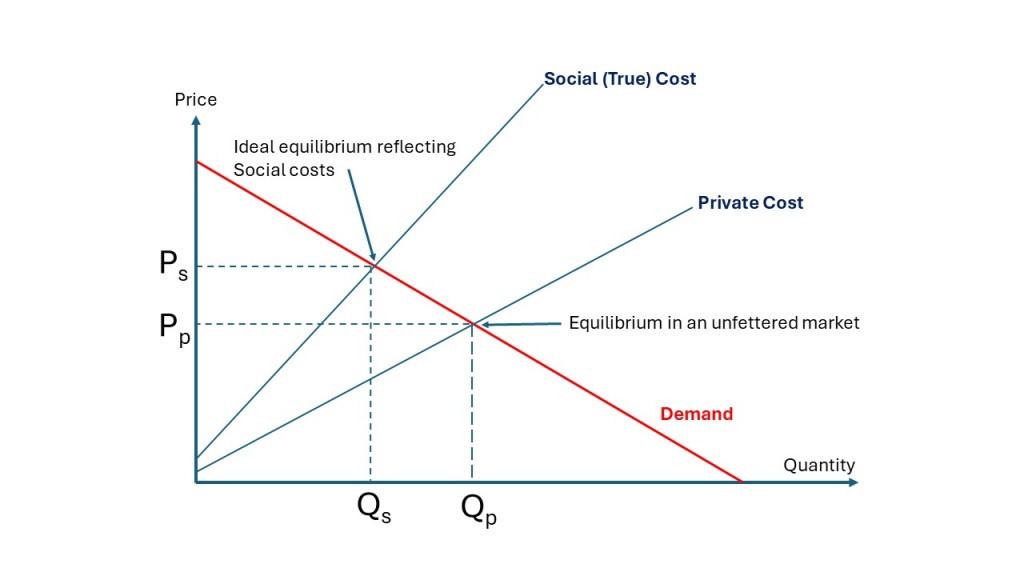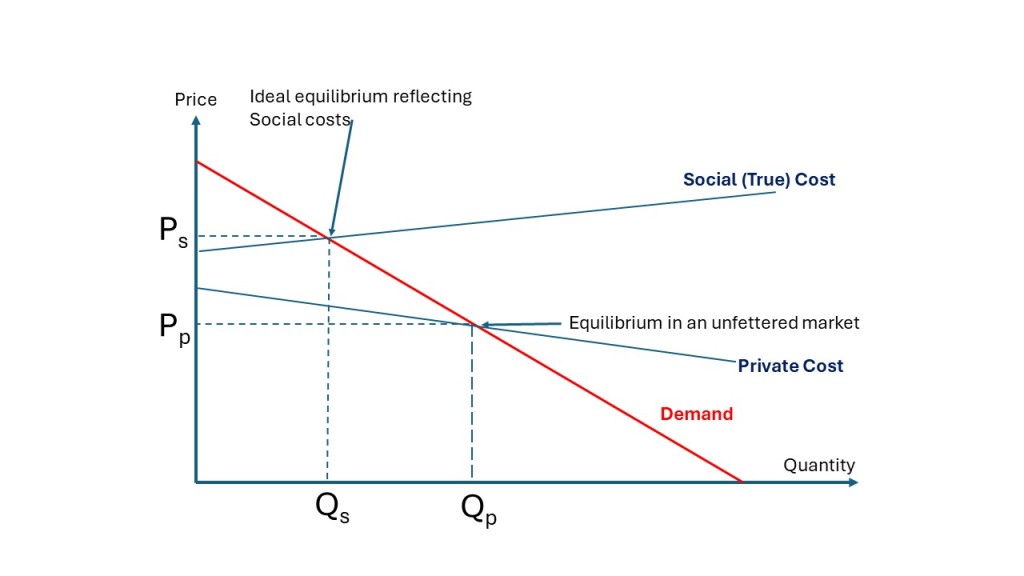Superfact 3 : Economic Externalities Are Spoilers of Free Markets
Economic externalities are spoilers of free markets. So called externalities result in unfettered free markets being non-optimal and can render the correct government intervention more effective even from a purely economic perspective. This comes as a big surprise to the market fundamentalists who believe that an unfettered free market is always the best approach for the economy.
An economic externality or external cost is an indirect cost or benefit to an uninvolved third party that arises as an effect of economic activities. They are unpriced components of market transactions.
An example is the gasoline you buy. Burning the gasoline causes pollution that harms other people including those who do not own cars, future generations, and it harms the environment including animals. Society incurs a cost from that pollution that you don’t pay for at the pump. The gasoline producers and vendors do not pay for it either. Unless you add a tax or make other adjustments the act of polluting is free of charge, even though there is a real cost associated with it. It is a cost that is invisible to unfettered “free markets”. It is a market failure.
Note I am putting “free markets” in quotes because the free market does not exist all by itself. It exists within a framework of laws, a banking system, and entities such as limited liability corporations, etc.

Economic Externalities
The existence of economic externalities is entirely uncontroversial among economists, including laissez-faire (libertarian) economists such as Milton Friedman, Friedrich Hayek, and Ludwig von Mises, even though Ludwig von Mises said that they arise from lack of “clear personal property definition.” In fact, Milton Friedman, Nobel prize winner in economics, and a leading anti-tax champion, stated that pollution met the test for when government should act, but that when it did so, it should use market principles to the greatest extent possible — as with a pollution tax. The unfettered free market is not optimal.

However, in my experience the existence of economic externalities is unwelcome news to less educated market fundamentalists, including many libertarian leaning politicians. I don’t have a Gallup poll to back this up, but I believe it is correct to say that economic externalities are controversial among a significant portion of the public despite being a universally accepted and a fundamental concept of economic science. Externalities are known to exist and that is not an easy pill to swallow for some.


In the simple supply-demand graphs above we see how the price of a product per unit (private cost / or production cost) varies with the increased quantities produced. In the first graph, as the production quantity increases the production cost per unit goes up perhaps because labor and other resources get increasingly rare. In the second graph, as the production quantity increases the production cost per unit goes down perhaps because production becomes more efficient with increased quantities.
In both cases demand goes down with quantity (the red demand curve/line) because fewer people want to buy more of the product as the quantity increases. In both cases the externality adds a cost. In this case the externality cost per unit goes up because increasingly damaging production methods are used as the quantity increases. There are many possible examples of these graphs, but the point is that the externality adds a cost that reduces quantity sold in a free market, assuming the cost of the externality is accounted for.
Economic Externalities In The Real Word
Unfortunately, in the real world, externalities are often not accounted for, and figuring out the real cost of an externality is a thorny issue. However, if we know the cost of the externality and have a way of accounting for it, perhaps via tax or a fee, then we would reach a new equilibrium, a new optimal price for the product that will include the social cost. I can add that in the 1920’s an economist Arthur Pigou argued that a tax, equal to the marginal damage or marginal external cost on negative externalities could be used to reduce their incidence to an efficient level.
Notice this tax is not for redistributing wealth or bringing revenue for the government but to reduce economic harm to society. There are other ways to address the problem, but this type of tax is called a Pigouvian tax.

Finally, I would like to give a few examples of negative and positive externalities. Negative externalities could be :
- Pollution
- Climate Change
- Depletion of fish due to overfishing
- Depletion of other resources
- Overuse of antibiotics
- Spam email
Some positive externalities are :
- A beekeeper keeps the bees for their honey, but a side effect or externality is the pollination of surrounding crops by the bees.
- Education (societal benefits beyond the individual).
- Research and development.
- Innovations
- Scientific discoveries
- Vaccination


